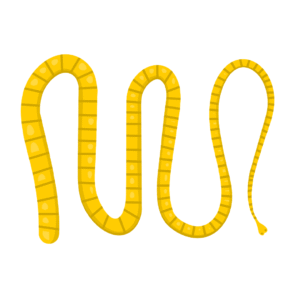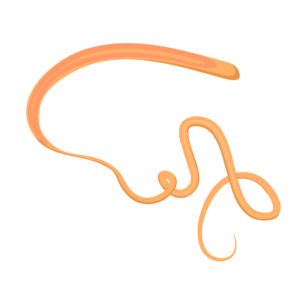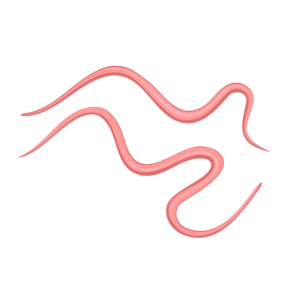Parasites have been troubling pets for centuries, and yet many owners are still on the fence with how to spot and treat them effectively.
In this blog, we discuss the most common parasites that your pets may face at some point in their lives, whether they’re scratching relentlessly because of fleas or scooting their bottom across the floor because of worms. Here’s what to look out for and what to do about it.
Tapeworms
Tapeworms are long, flat and segmented worms that look like grains of rice strung together. They attach themselves to the intestinal lining of your pet, where mature segments then breakaway and are left in faeces or around the base of your pet’s tail. Tapeworms are usually spread when our pets ingest fleas or small rodents that are infected, but infestation is not always obvious. However, some of the symptoms can include: a poor coat, poor body condition weight loss, rubbing their bottoms on the floor, and worms by their back end.
You may notice segments of adult tapeworms in your dog or cats’ faeces which cause a great deal of irritation for your pet. If your pet keeps licking around their tail, you find worms by their back end, or they are rubbing their bottoms on the floor, this could be a sign of tapeworm infestation.

Roundworms
There are various types of roundworms. They are similar to earthworms in shape, but thinner and can grow to around 15cm in length. Roundworms live in the animal’s stomach and intestines and can be passed whole in the animal’s faeces or vomit.
Signs of roundworm can appear differently depending on your pet’s age. For instance, adult cats and dogs may experience weight loss, vomiting and an upset stomach, meanwhile puppies and kittens are likely to have a potbellied look as well.

Hookworms
Hookworms attach themselves to the intestinal lining, where they feed on pet’s blood. They release eggs in pet’s faeces, which hatch into larvae that live in soil. Pets can get infected through ingesting worm eggs from contaminated soil or when grooming. Cats appear to have more of a resistance to hookworms than their canine counterparts, and so cat wormer products may not state they treat hookworms.
Signs of hookworms are pale gums, rejecting food, and bloody or dark diarrhoea. As hookworms feed on your pet’s blood, they can be a serious threat to younger and already unwell pets.

Treating Worms
Unfortunately, puppies and kittens can be born with various types of worms, so it’s vital to understand your worming options if your pet has a new litter or you’ve welcomed a new little friend into your home. Johnsons One Dose Wormer for Puppies & Small Dogs can be given to puppies from 12 weeks of age, or over 2kg bodyweight, whilst our One Does Wormer for Cats & Kittens can be given from the age of 6 weeks old.
For most adult cats and dogs, you should treat your pets at the sign of infestation or according to your pet’s lifestyle. For example, farm cats or dogs who tend to eat everything in sight may need to be treated on a more regular basis, but a housecat is less likely to require such regular treatment.
Fleas
Probably the most common and annoying pet parasite – the flea. These tiny little insects live in pet fur (and in our homes!) feeding of their hosts’ blood, such as foxes, hedgehogs, birds or other infected pets, and should be treated with a suitable product. Both dogs and cats get fleas from encountering other animals that are infested with fleas. Small animals such as rabbits, guinea pigs and hamsters can also get fleas.
The adult flea is easily recognised by their small, dark brown appearance as they scurry through pet fur. Although you may think they are the root cause of your furry friend’s discomfort, the adult flea only makes up 5% of the flea lifecycle. The flea egg makes up 50% of the flea’s life, making it the most stubborn stage to get rid of. An adult female flea lays 20-50 eggs per day, which can be found on pets and in bedding, carpets, and other furnishings. An infestation can easily take hold and continue for months if not taken care of effectively.

Treating Fleas
The new Guardian Plus Spot On for Cats and Guardian Plus Spot On for Dogs kills adult fleas and prevents the development of flea eggs and larvae. This effectively breaks the flea lifecycle and allows you to remove these nasty squatters from your pet and home. A bonus of the new Guardian Plus Spot On treatment is that it also kills ticks and lice on your pet.
For complete protection, we recommend pairing our spot on treatments with our Guardian Home Flea Spray. We have a handy blog on treating your home for fleas that should help your efforts in eradicating flea problems.
For small animals such as rabbits and guinea pigs, we recommend reading our caring for small pets in summer guide. This details everything you can do to treat your little furries when they are experiencing fleas.
Ticks
Ticks are small spider-like parasites that suck blood from their host causing irritation and disease with potentially serious consequences. Found in dense, moist vegetation, they will crawl into a pet’s fur as they brush past. Owners need to be checking their pet and themselves for ticks after every walk in the fields.
There are 20 species of tick present in the United Kingdom, and some can carry harmful bacteria such as Lyme Disease. This is a serious problem in humans and can also be contracted in cats and dogs.

Treating Ticks
If you notice a tick on your pet, removing them is easy. However, it is important to do it correctly to avoid any issues. Simply pick up a Tick Remover Tool, insert the hook under the tick, lift the hook lightly gently twisting, and the tick should come away from their skin. You can also administer a spot on treatment like the Guardian Spot On range to kill any ticks you can’t see within 48 hours.
Lice
Lice might be the most uncommon pet parasite in our list, but that’s not to say they don’t cause big problems for pets. There are sucking and chewing lice that can attack dogs, typically targeting vulnerable dogs and pets living in dirty or overcrowded conditions. Chewing lice are the only type to affect cats in the UK, mostly infesting elderly cats who struggle to groom themselves.
One positive is that lice are species specific, meaning it’s very unlikely for cat or dog lice to transmit to humans and vice versa.
Pet lice look similar to head lice in humans; you may be able to see lice crawling or see eggs attached to your pet’s fur. Your pet could experience hair loss and scratch more than usual.

Treating Lice
There are several ways to treat lice on your pets, predominantly through spot on treatments, such as our triple action Guardian Spot On treatment (do not apply to pets before bathing, only afterward) and give all of your pet’s bedding a good hot wash. If you are still concerned about lice on your pet, you should consult a veterinarian for the best course of action depending on the specific situation.
Keeping the parasites at bay
Keeping your pets healthy and happy means staying vigilant against the common parasites that can disrupt their lives and yours! From fleas and ticks to worms and lice, understanding the signs of infestation and knowing how to treat them is key to ensuring your furry friends stay comfortable and safe. Checking regularly, treatments like spot-ons, and maintaining a clean environment can go a long way in protecting your pets from these pesky invaders.
Remember, every pet is unique, so make sure to tailor a parasite plan that suits you and your pet’s lifestyle.





